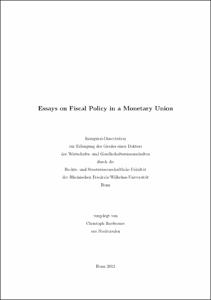Essays on Fiscal Policy in a Monetary Union

Essays on Fiscal Policy in a Monetary Union

| dc.contributor.advisor | von Hagen, Jürgen | |
| dc.contributor.author | Bierbrauer, Christoph | |
| dc.date.accessioned | 2020-04-17T18:55:21Z | |
| dc.date.available | 2020-04-17T18:55:21Z | |
| dc.date.issued | 01.08.2012 | |
| dc.identifier.uri | https://hdl.handle.net/20.500.11811/5251 | |
| dc.description.abstract | This thesis consists of three separate, but interlinked chapters on national fiscal policy in a monetary union. Throughout, I employ new Keynesian models that are augmented by the introduction of overlapping generations of the Blanchard-Yaari type. The first chapter presents an analytically tractable two-country model of a currency union, which abstracts from distortions other than sticky prices in the goods market and failures of the Ricardian equivalence. Here, the government chooses a certain level of public spending. The government's options of financing its public spending are limited to public debt or taxation. I find that, depending on the financing decision of the government, fiscal policy measures can have very different effects on key macroeconomic variables. The spillovers of national fiscal policy depend on the composition of government spending, the type of the fiscal measure and the cross-country substitutability between goods. The second chapter restricts the attention to a new Keynesian closed economy model that features public as well as private investment. The government is in a position to employ either spending-side measures, i.e. cuts in public consumption, or improve public revenues in order to finance a temporary fiscal expansion. Both, the financing decision as well as possible failures of the Ricardian equivalence have a large impact on how fiscal measures affect key macroeconomic variables. The results suggest that a single deviation from the standard model, e.g. failures of the Ricardian equivalence, is not sufficient to reconcile theory and empirical evidence. The last chapter builds on these findings and develops the issue further by extending the model of chapter 2 to a two-country model of a currency union. I focus on fiscal measures that are frequently employed in practice. When assessing the impact of central components of the European Economic Recovery Plan on the economy of the implementing country, I look also at the implied spillovers. Finally, a brief summariy of some major results of the three chapters: Failures of the Ricardian equivalence enable theoretical models to yield predictions that are close to empirical evidence. However, this comes at the price of deviating from the Ricardian equivalence in a way which cannot be confirmed empirically. The introduction of a more complex fiscal sector and the assumption that fiscal policy is endogenous, allows for moving theoretical predictions closer to the empirical evidence without having to rely crucially on deviations from Ricardian behavior. My results suggest that focusing on distortions in intertemporal optimization is a too narrow approach to tackle with research questions related to the conduct and effects of fiscal policy in theoretical models. | en |
| dc.language.iso | eng | |
| dc.rights | In Copyright | |
| dc.rights.uri | http://rightsstatements.org/vocab/InC/1.0/ | |
| dc.subject | Fiskalpolitik | |
| dc.subject | Konjunkturpaket | |
| dc.subject | Konjunkturlokomotive | |
| dc.subject | Währungsunion | |
| dc.subject | Europäische Wirtschafts- und Währungsunion | |
| dc.subject | EWWU | |
| dc.subject | Wachstumspaket | |
| dc.subject | Steuern | |
| dc.subject | Budgetkonsolidierung | |
| dc.subject | Ausgabenkürzung | |
| dc.subject | Staatsausgaben | |
| dc.subject | fiscal policy Economic and Monetary Union | |
| dc.subject | European monetary union | |
| dc.subject | budget consolidation | |
| dc.subject | public budget | |
| dc.subject | Spending Reversals | |
| dc.subject | fiscal stimulus | |
| dc.subject | European Economic Recovery Plan | |
| dc.subject | government spending | |
| dc.subject | multiplier | |
| dc.subject | Keynesian multiplier | |
| dc.subject | public consumption | |
| dc.subject | public investment | |
| dc.subject | tax cut | |
| dc.subject.ddc | 330 Wirtschaft | |
| dc.title | Essays on Fiscal Policy in a Monetary Union | |
| dc.type | Dissertation oder Habilitation | |
| dc.publisher.name | Universitäts- und Landesbibliothek Bonn | |
| dc.publisher.location | Bonn | |
| dc.rights.accessRights | openAccess | |
| dc.identifier.urn | https://nbn-resolving.org/urn:nbn:de:hbz:5-29415 | |
| ulbbn.pubtype | Erstveröffentlichung | |
| ulbbnediss.affiliation.name | Rheinische Friedrich-Wilhelms-Universität Bonn | |
| ulbbnediss.affiliation.location | Bonn | |
| ulbbnediss.thesis.level | Dissertation | |
| ulbbnediss.dissID | 2941 | |
| ulbbnediss.date.accepted | 04.07.2012 | |
| ulbbnediss.fakultaet | Rechts- und Staatswissenschaftliche Fakultät | |
| dc.contributor.coReferee | Müller, Gernot J. |
Dateien zu dieser Ressource
Das Dokument erscheint in:
-
E-Dissertationen (288)




